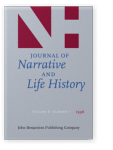Looking for Frogs in the Narrative Stream: Global and Local Relations in Maternal Narratives
Abstract
In this study, we compared storytelling of a pictured narrative, Frog, Where Are You?, by 6 Deaf and 6 hearing mothers in American Sign Language (ASL) and in English, respectively. How do these mothers construct their stories, that is, how do they mark episodes? And how do English-speakers' strategies differ from ASL-users' strategies? We found that stories in ASL contained more explicit markers to signal both local and global relations of the narrative. Because of modality and grammatical differences between English and ASL, Deaf mothers seemed to have more strategies available to use. Although the overall pattern of use throughout the story was similar, Deaf mothers appeared to be more "dramatic" in their storytelling than were hearing mothers. Both groups of parents used a variety of markers to call their children's attention to the theme of the story. (Psychology)
References
Baker, C., & Cokely, D.
(
1980)
American Sign Language: A teacher's resource text on grammar and culture. Silver Spring, MD: TJ Publishers.

Bamberg, M.
(
1987)
The acquisition of narratives. Berlin: deGruyter.


Bamberg, M., & Marchman, V.
Berman, R.
(
1988)
On the ability to relate events in narrative.
Discourse Processes, 111, 469–497.


Berman, R., & Slobin, D. I.
(
1994)
Relating events in narrative: A crosslinguistic developmental study. Hillsdale, NJ: Lawrence Erlbaum Associates, Inc.

Grimes, J.
(
1975)
The thread of discourse. The Hague, Netherlands: Mouton.


Grimes, J.
(
1978)
Narrative structures in oral texts. In
W. U. Dressier (Ed.)
Current trends in text linguistics (pp. 123–32). Berlin: DeGruyter.


Karmiloff-Smith, A.
(
1981)
The grammatical marking of thematic structure in the development of language production. In
W. Deutsch (Ed.)
The child's construction of language (pp. 23–52). London: Academic.

Klima, E., & Bellugi, U.
(
1979)
The signs of language. Cambridge, MA: Harvard University Press.

Labov, W., & Waletzky, J.
(
1967)
Narrative analysis: Oral versions of personal experience. In
J. Helm (Ed.)
Essays on the verbal arts (pp. 12–44). Seattle: University of Washington Press.

Liddell, S.
(
1980)
American Sign Language syntax. The Hague, Netherlands: Mouton.

Mandler, J.
(
1978)
A code in the node: The use of a story schema in retrieval.
Discourse Processes, 11, 14–35.


Mandler, J., & Johnson, N. S.
(
1977)
Remembrance of things parsed: Story structure and recall.
Cognitive Psychology, 91, 111–151.


Mayer, M.
(
1969)
Frog, where are you?. New York: Dial.

Provine, K., & Reilly, J.
(
1992, October)
The expression of affect in signed and spoken languages. Poster presented at the fourth meeting of the American Psychological Society, San Diego, CA.

Reilly, J. S., McIntire, M. L., & Anderson, D.
(
1994, November)
Look who's talking! Point of view and character reference in mothers' and children's ASL narratives.. Paper presented at the 19th Boston University Conference on Language Development, Boston.

Reilly, J. S., McIntrie, M. L., & Bellugi, U.
(
1990)
The acquisition of conditionals in American Sign Language development: Grammaticized facial expressions.
Applied Psycholinguistics, 111, 369–392.


Reilly, J. S., Mclntire, M. L., & Bellugi, U.
(
1991)
Baby face: A new perspective on universals in language acquisition. In
P. Siple &
S. D. Fischer (Eds.)
Theoretical issues in sign language research: Vol. 2. Psychology (pp. 9–23). Chicago: University of Chicago Press.

Rumelhart, D. E.
(
1975)
Notes on a schema for stories. In
D. G. Bobrow &
A. Collins (Eds.)
Representation and understanding: Studies in cognitive science (pp. 211–236). New York: Academic.


Supalla, T.
(
1982)
Structure and acquisition of verbs of motion and location in American Sign Language. Unpublished doctoral dissertation, University of California, San Diego.

Cited by
Cited by 1 other publications
Brentari, Diane
2019.
Sign Language Phonology,

This list is based on CrossRef data as of 2 april 2024. Please note that it may not be complete. Sources presented here have been supplied by the respective publishers.
Any errors therein should be reported to them.
